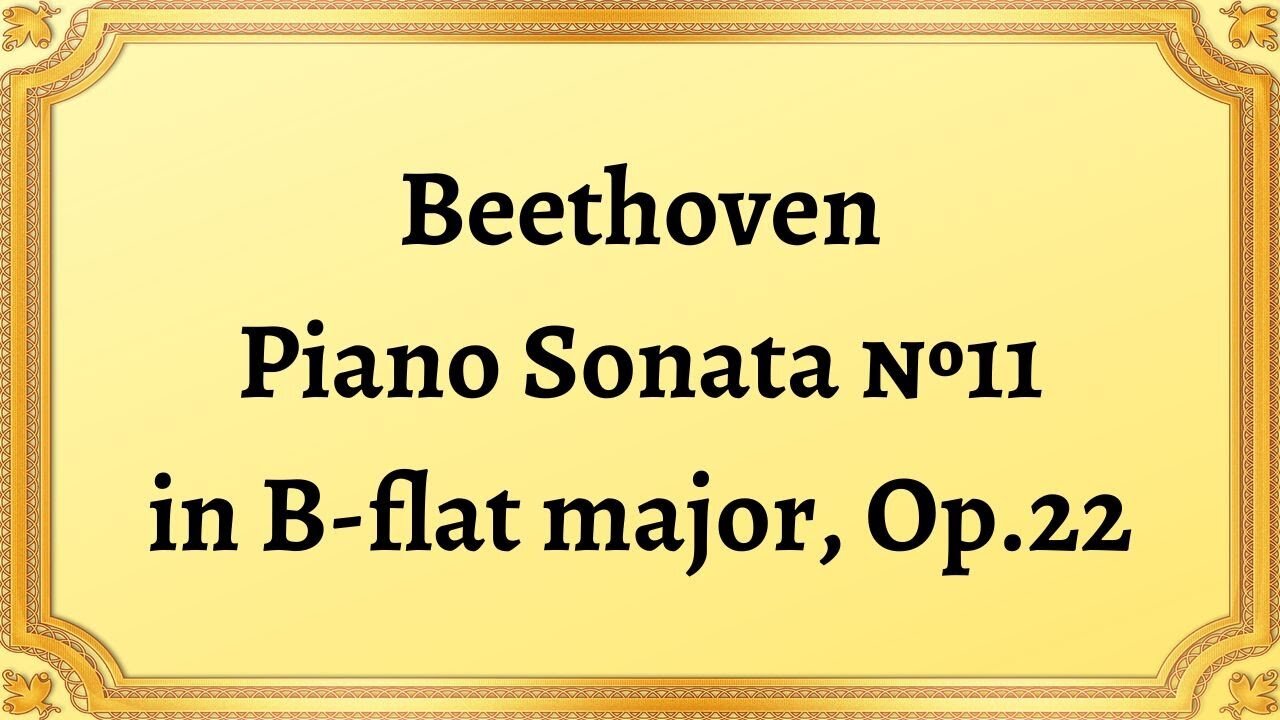Premium Only Content

Beethoven Piano Sonata №11 in B-flat major, Op.22
#classical_music #Beethoven #Piano_Sonata
Beethoven's Piano Sonata No. 11 in B-flat major, Op.22, is a remarkable composition that showcases the genius of the renowned composer.
Beethoven composed Piano Sonata No. 11 in B-flat major, Op.22, during the classical period of music in the late 18th century. It was published in 1801, reflecting the artistic progression of Beethoven's early works. This sonata holds great significance as it marks a significant development in Beethoven's style and demonstrates his mastery of the piano.
This sonata comprises four movements: Allegro con brio, Adagio con molto espressione, Menuetto, and Rondo: Allegretto. The key of B-flat major imparts a sense of grandeur and brightness to the composition. Each movement contributes to the overall narrative, offering distinct musical expressions that captivate listeners.
The first movement, Allegro con brio, commences with a spirited and lively theme. It showcases Beethoven's trademark use of dynamic contrasts, melodic inventiveness, and rhythmic complexity. The second movement, Adagio con molto espressione, contrasts the previous movement with a serene and introspective atmosphere, highlighting Beethoven's ability to evoke profound emotions.
The Menuetto, serving as the third movement, exudes a dance-like character. It presents a graceful melody and a contrasting trio section that adds a touch of playfulness. Beethoven's skillful incorporation of symmetrical phrases and harmonic surprises adds depth and intrigue to this movement.
The final movement, Rondo: Allegretto, brings the sonata to a lively and joyous conclusion. It features a recurring main theme that undergoes various transformations, demonstrating Beethoven's thematic development. The virtuosic passages and sparkling melodies exhibit the composer's technical prowess and musical inventiveness.
Beethoven's Piano Sonata No. 11 in B-flat major, Op.22, stands as a testament to the composer's artistic evolution and his significant impact on the classical music landscape. This composition exemplifies Beethoven's ability to push the boundaries of musical expression, paving the way for future composers. Its profound influence can be heard in the works of later Romantic-era composers, who were inspired by Beethoven's innovative approach.
Beethoven's Piano Sonata No. 11 in B-flat major, Op.22, represents a significant milestone in the composer's illustrious career. Its historical significance, impeccable structure, and musical richness continue to enthrall audiences worldwide. This sonata serves as a testament to Beethoven's enduring legacy and his contributions to the world of classical music. Whether explored by scholars, performed by virtuoso pianists, or cherished by music enthusiasts, this composition continues to inspire and captivate, bridging the gap between the past and the present.
-
 6:07
6:07
Classical music_Music Inspiration
11 days agoJoseph Haydn Piano Sonata in D Major, Hob. XVI:51
401 -
 UPCOMING
UPCOMING
Wendy Bell Radio
4 hours agoTaking Out The Trash
2.77K10 -
 UPCOMING
UPCOMING
Graham Allen
1 hour agoDems Try To RAID USAID Office!! + Trump Meets With Netanyahu In The Oval Office! Peace Is HERE!!
1.48K1 -
 LIVE
LIVE
Vigilant News Network
13 hours agoRFK Jr. Clears Major Hurdle for HHS Secretary | The Daily Dose
1,019 watching -
 LIVE
LIVE
Game On!
14 hours ago $0.13 earnedTom Brady's SHOCKING Super Bowl Pick!
1,434 watching -
 UPCOMING
UPCOMING
Jeff Ahern
26 minutes agoNever Woke Wednesday with Jeff Ahern (6am Pacific)
-
 18:52
18:52
Producer Michael
17 hours agoI GOT PULLED OVER BY THE POLICE IN MIAMI!
34.4K3 -
 1:21:53
1:21:53
MTNTOUGH Fitness Lab
22 hours agoThe Fight That Almost Destroyed Jim Miller (& How He Overcame It) to Break UFC Records
48.2K3 -
 24:46
24:46
Cooking with Gruel
1 day agoFeeding Hope - LA Wildfire Relief from the People
34.6K7 -
 14:34
14:34
MichaelBisping
14 hours agoSean Strickland CONFRONTS Bisping! 'Pereira in Corner, Dricus and Khamzat!' (EXCLUSIVE INTERVIEW)
16.1K3